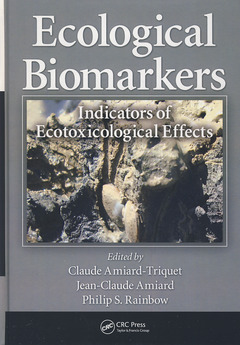Ecological Biomarkers Indicators of Ecotoxicological Effects
Coordonnateurs : Amiard-Triquet Claude, Amiard Jean-Claude, Rainbow Philip S.

Does a change, which affects a few biological macro-molecules, some cells, or a few individuals within a population, have any ecological significance that would allow the prediction of deleterious effects at higher levels of biological organization, namely the population, community, and ultimately the ecosystem? With contributions from experts in the field, Ecological Biomarkers: Indicators of Ecotoxicological Effects explores how biomarkers can be used to predict effects farther down the chain. It presents a synthesis of the state of the art in the methodology of biomarkers and its contribution to ecological risk assessment.
This book describes the core biomarkers currently used in environmental research concerned with biological monitoring, biomarkers which correspond to the defences developed by living organisms in response to contaminants in their environment, and biomarkers that reveal biological damage resulting from contaminant stressors. It examines the efficacy of lysosomal biomarkers, immunotoxicity effects, behavioral disturbances, energy metabolism impairments, endocrine disruption measures, and genotoxicity as all indicative of probable toxic effects at higher biological levels.
It is time to revisit the biological responses most ecologically relevant in the diagnosis of the health status of an aquatic environment well before it becomes unmanageable. Biomarkers provide a real possibility of delivering an easily measured marker at a simple level of biological organization that is predictably linked to a potentially ecologically significant effect at higher levels of biological organization. The text explores the latest knowledge and thinking on how to use biomarkers as tools for the assessment of environmental health and management.
Introduction. History of Biomarkers. Biomarkers of Defence, Tolerance and Ecological Consequences. Biomarkers of Damage. Sentinel Species. Linking Lysosomal Biomarkers and Ecotoxicological Effects at Higher Biological Levels. Impairments of Endocrine Functions: Causes and Consequences. Impairments of Endocrine Functions: Case Studies. Behavioral Ecotoxicology. Origin of Energy Metabolism Impairments. Consequences of Energy Metabolism Impairments. Genotoxicity Markers and In Situ Individual and Populational Effects. Genetic Variability and Gene Expression. Biomarkers in the Assessment of The Ecotoxicological Status Of Aquatic Habitats.
Dr. Claude Amiard-Triquet is a Research Director in the CNRS (French National Research Center) based at the University of Nantes, France. Dr. Amiard-Triquet's research interests include metal ecotoxicology, biomarkers, and emerging contaminants (endocrine disruptors, nanoparticles).
Professor Jean-Claude Amiard is a Research Director in the CNRS (French National Research Center) based at the University of Nantes, France. His research activities have focused on the fate and effects of trace metals in marine and estuarine ecosystems, the tolerance of organisms to chronic exposure to contaminants, and the application of biomarkers to the assessment of ecotoxicity of emerging contaminants.
Professor Philip Rainbow is the Head of the Department of Zoology at the Natural History Museum, London, leading a staff of more than 100 working scientists. His recent research has focused on the factors affecting the bioavailability of trace metals to aquatic invertebrates from both solution and the diet, and the biodynamic modeling of trace metal bioaccumulation.
Date de parution : 01-2013
Ouvrage de 450 p.
17.8x25.4 cm
Thèmes d’Ecological Biomarkers :
Mots-clés :
Endocrine Disruption; Dreissena Polymorpha; biomarkers; Zebra Mussel; energy metabolism; DNA Damage; immunotoxicology; Digestive Gland; genotoxicity; DNA Adduct; Seine Estuaries; AChE Activity; Core Biomarkers; Scrobicularia Plana; Lysosomal Stability; English Sole; Biomarker Response; Lysosomal Membrane; Confounding Factors; VTG Concentration; Chemical Stress; Nereis Diversicolor; Fundulus Heteroclitus; Ice; Oncorhynchus Mykiss; Digestive Enzyme Activities; Behavioral Biomarkers; Sentinel Species; NS NS


